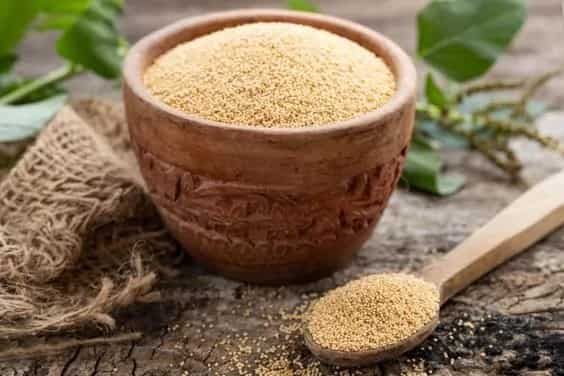Many people fast during the Navratri season to celebrate the festival. It is critical that those who are fasting consume food that is both healthy and balanced, and contains the correct nutrients. Cheela, rotis, pooris, and various other fasting-friendly foods are made using sabudana, kuttu, samak, and rajgira. Not only are they full of nutritional qualities, but they also have several health advantages. Chaulaikeladdoo, a North Indian sweet made of rajgira grains and jaggery, is a frequently eaten fasting-friendly snack during Navratri.
What is Rajgira/Amaranth?
When rajgira seeds are roasted over a hot pan until they pop and are then mixed with molten jaggery, the resulting chikkis are crunchy, sweet, and tasty. In addition to being used to make khichdis, parathas, laddoos, dosas, and patties, rajgira flour has been used for centuries by the Gujarati community of India to make pankis, puris, puran polis, bhakarwadi, and parathas. Maharashtrians, in contrast, consume rice during religious fasts and therefore use buckwheat, singada (water chestnut), and rajgira in addition to rajgira flour to make up for the loss of wheat and rice.
In ancient times, the Aztecs consumed amaranth widely, as it was a key part of their diet. Amaranth is now grown in other parts of the world, including China, India, Southeast Asia, and Africa.

What does it taste like?
It has a nutty taste along with a subtle sweetness.
What nutrients does it contain?
It contains manganese, magnesium, phosphorus, and iron, as well as vitamins C, B6, and B3. NASA chose quinoa and amaranth as the basis of an improved diet for astronauts, since they are so nutritious and medicinal.
How to utilize amaranth in food?
Amaranth is a superfood that can easily be used to make food. You can incorporate it into your meals in a variety of ways, like in rice, pancakes, batter, dough, soup, and sweet preparations, for instance. In addition to being used as a component in puffed snack bars with chia, quinoa, and flax seed, it can be a nourishing food prior to and after workouts.
Benefits and uses of Amaranth
Amaranth leaves also provide cosmetic benefits by reversing hair thinning and boosting hair follicle health as it is loaded with amino acids and minerals. So, let’s take a look at some of the benefits of including this healthy grain in your diet:
1. 1. Boosts immunity
Amaranth is a special grain because it is jam-packed with vitamin C, which helps the body produce white blood cells, which in turn helps the injury or repair process go faster.
2. 2. Lowers cholesterol
According to certain animal studies, rajgira and its oil have the potential to reduce blood cholesterol levels. Triglycerides and LDL cholesterol are significantly lowered by the phytosterols and oils in amaranth, which lower cholesterol without lowering the good cholesterol.
3. 3. Used for weight loss
Amaranth can help you lose weight by providing plenty of protein and fiber. Rajgira-based meals are perfect for those looking for high-protein foods. Because of the protein and fiber content of amaranth, we feel fuller for longer, lowering our appetite and calorie intake.
4. 4. Gluten-free and good for diabetics
Because it is gluten-free, Rajgira is excellent for people with celiac disease or gluten sensitivity. It also provides fiber, helps control blood sugar levels, and promotes satiety.
5. 5. Good for treating anemia
Eating Rajgira seeds helps to increase the production of red blood cells and boost cellular metabolism, thereby reducing the chances of getting anemia. Besides, consuming these fruits guarantees maximum absorption of iron into the blood.

Here’s a recipe to make rajgira laddoos:
Ingredients:
• One cup of rajgira seeds
• One cup of jaggery
• Water
Directions:
• Keep a pan on a medium flame and add one tablespoon of rajgiraseeds at a time; roast till they pop.
• In another pan, add the jaggery and melt it with water. Stir it until it becomes a syrup.
• Add this melted jaggery syrup to the popped amaranth seeds and mix it well.
• Apply some water to your palms and roll them into laddoos. Enjoy!
Side effects of eating Rajgira
Boiling or cooking the leaves eliminates the harmful oxalic acid in them. Studies indicate that if too much of this food is taken raw in grain form, we risk a large dose of oxalates, which may adversely affect kidney health.
How much does it cost?
Rajgira is sold in grocery shops and through online e-commerce portals too. It costs approximately INR 70 per kg.


